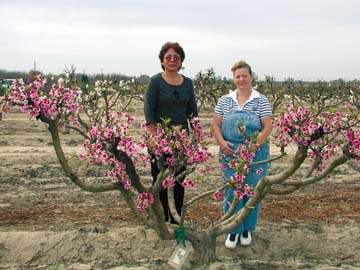|
Dec. 30, 2004
Zen and the Art of Apple Tree Maintenanceby AMY STEWART "I EXPECT TO FULLY MASTER
THE ART OF PRUNING BY the time I'm 80 years old." That's
how Michael Phillips, author of The Apple Grower: A Guide
for the Organic Orchardist, begins his chapter on pruning.
It's not an encouraging start. I didn't think it would be all that complicated to care for an apple tree until I planted one. I bought a tree, evaluated the young plant's branching structure, and vowed to make a few judicious cuts after the first year. But somehow a couple of winters passed and I never even touched the tree. I was paralyzed by indecision and inexperience.
In fact, there is an art and a science to the pruning of fruit trees. It's helpful to know how to use phrases like "stubbing cut" and "water sprout" in a sentence, and to be able to discuss the pros and cons of the open vase style as opposed to the modified central leader style. And you'll have to navigate through advice like this: "Midsummer is the time to snip back the four or so invigorated top shoots (caused by heading the whip back at planting time) to the chosen leader. Laterals just below these sharp-angled upper shoots are left to develop as scaffold candidates for the following year." I've had better luck with stereo instructions. But an academic grasp of the facts isn't enough: Phillips encourages "oneness with the tree" and advises approaching the tree with an "introductory intake of the breath." Maybe that's my problem. I'd been approaching the tree with a bottle of Alleycat Amber in one hand and a pair of rusty pruning shears in the other, humming "Octopus's Garden" and paying no attention to my breathing whatsoever. Inevitably I'd lose my nerve, drop into a chair next to the tree, finish my beer and resolve to study Phillips' book again before I had another go at it. Fruit tree growers, perhaps exasperated by the utter incompetence of gardeners like me, have developed new techniques for "no prune" bareroot trees that will survive benign neglect and rough handling. The new EZ-PICK trees from the L.E. Cooke Company in Visalia are one such example; their novel approach to grafting and rootstock selection result in a tree that, they claim, requires very little specialized pruning, produces fruit a year or two earlier, and takes up no more space than a large shrub. Sales rep Lloyd Cassidy described how it works. "We start with a 2-year-old rootstock," he said, "and this is a rootstock that would normally produce a full-sized tree. Then we graft the fruiting wood on and force a branching structure that will be easy to maintain." The first branches, he said, would be only 10-18 inches above ground, and the tree will already have been trained in an open vase shape to encourage a short, shrubby habit that allows sunlight into the center of the tree. "You'll prune it in the dormant season to keep the open shape," he said, "and do a little light summer pruning to keep it down to the size you want." The use of larger, more mature rootstock forces the tree to set fruit earlier. "We graft a little bit of fruiting wood onto those 2-year-old rootstocks," Cassidy said, "and all that energy gets pushed right into the tree." Photos of EZ-PICK trees show wide, graceful nectarine trees that would not be out of place in a Japanese garden; the highest branch doesn't reach 5 feet tall. Young plum and apple trees are shorter than the women standing around them and already producing fruit. The notion of an apple shrub might take some getting used to, but the idea has merit: the trees could make themselves at home in a perennial border and would even do well in a tiny courtyard. I don't know if I'm ready to commit to another fruit tree, but if you've got a few feet of space, you might give EZ-PICK a try. L.E. Cooke is using this approach with apples, pears, apricots, peaches, plums and cherries. You can't order directly from the grower -- it's a wholesaler grower only -- but a selection of them will be available at Pierson's next month. And if you feel that you require professional instruction to take care of the trees you've got, remember that Miller Farms' apple tree workshops are among their most popular events of the year. They'll be offering one in January; call 839-1571 to sign up. garden-related announcements and news to Amy Stewart. IN THE NEWS | COVER STORY | THE HUM | CALENDAR © Copyright 2004, North Coast Journal, Inc. |


